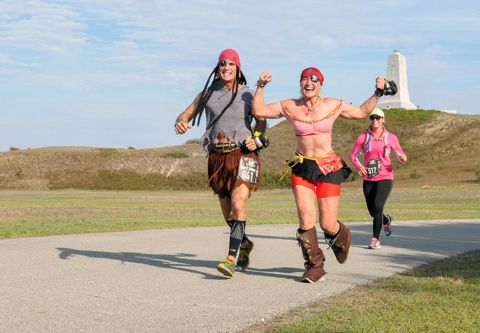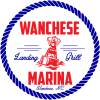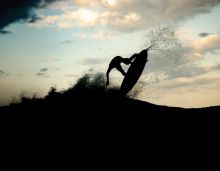
Plenty of beach towns claim a deep connection to East Coast surfing, but no other place quite measures up to the Outer Banks. This stretch of North Carolina barrier islands, over 100 miles long, has a reputation as the East Coast’s number 1 surfing destination, and it’s not just hype.
Thanks to its location near the Continental Shelf and underwater topography with shifting sandbars, the Outer Banks offers the most consistent waves on the East Coast. Hurricanes and storms bring in big swells, and with both east-facing and south-facing beaches, the Outer Banks islands are situated to receive swells from multiple directions, which increases the odds of catching waves in varying winds.
The epicenter of Outer Banks surfing, Cape Hatteras juts out about 30 miles from the mainland and takes the brunt of powerful Atlantic swells. It’s a magnet for surfers seeking serious waves and has helped shape some of the world’s best riders. But surfers do not have to be experts to surf on the Outer Banks, which has long been a welcoming spot for beginners, weekend warriors, diehards and professionals, from the very young to the very old.
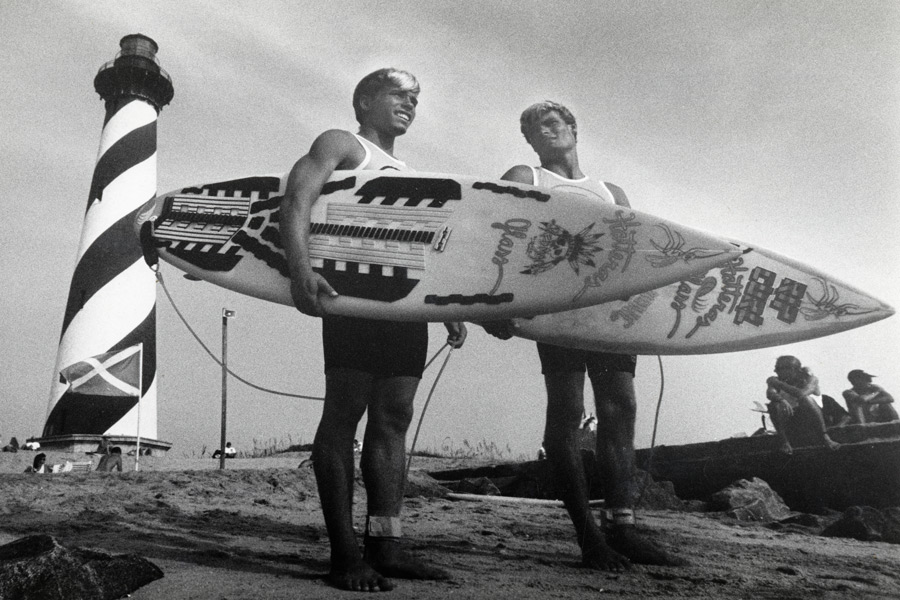
Image appears courtesy of the Outer Banks History Center, State Archives of North Carolina.
Surfers have been riding waves here for nearly 70 years, but not always in the great numbers of today. So how did this place rise to the status of an East Coast surfing hotspot?
Books like Surfing NC: A Timeline of the History of Sport of Surfing in North Carolina by John Hairr and Ben Wunderly and Surfing Virginia Beach and the Outer Banks by Tony Lillis are helpful for laying out the timelines and were used primarily for the information below, along with various media articles, personal interviews and the exhibit “Where the Waves Break: Surfing in Northeastern North Carolina,” which was recently on display at the Museum of the Albemarle in Elizabeth City.
According to Surfing NC, riding waves on boards dates way back to the Polynesian islands in the early 1900s, but the first recorded account of wave-riding on the Outer Banks was in 1928, when Hawaiian performers led by Willie Kaiama demonstrated surfing during Virginia Dare Day celebrations.
By the early 1930s it’s said that Thomas Fearing of Manteo had built a surfboard-style board to paddle out into the ocean. His board was so heavy it took two men to carry it to the ocean, and while he did not have success riding waves, he was successful using it as a paddleboard to access spearfishing sites. His buddy David Stick later sold handmade juniper “surfboards” in his Kitty Hawk Craft Shop — although by today’s standards they were more like wooden bodyboards.
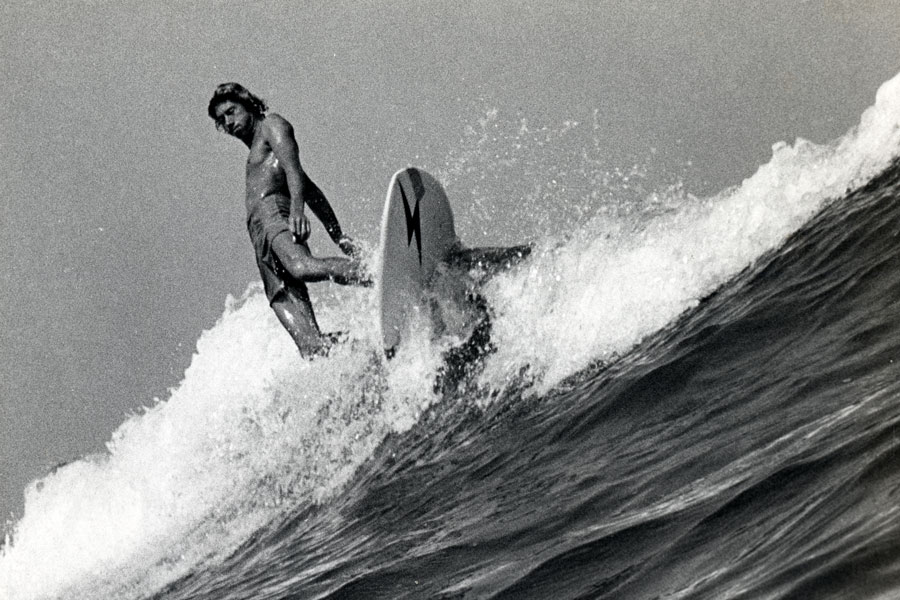
Image appears courtesy of the Outer Banks History Center, State Archives of North Carolina.
In this region, surfing was pioneered in nearby Virginia Beach first and then trickled down to the Outer Banks. Guys like Dusty Hinnant and John Smith are credited with getting surfing going in Virginia Beach when they built and rented surfboards as part of their beach services and lifeguard business in the 1930s. They had met Californian Tom Blake, considered the father of modern surfing, in Florida and brought his ideas back home. One of their fellow Virginia Beach surfing pioneers, Robert Holland Sr., taught his son, Bob Holland, to surf in 1939. Searching for better waves, the younger Holland began surfing the Outer Banks in the 1950s. He opened Holland Surf Shop in Kill Devil Hills in 1969. Holland evolved into a champion surfer and surfed the Outer Banks until he was 84.
With Virginia surfers crossing into the Outer Banks and the sport of surfing entering popular culture in the United States in the 1950s, it was not long before the local Outer Banks guys caught the bug. Budding Outer Banks surfers have said they watched Bob Holland to learn how to surf.
It is documented that in 1961, a group of teens from Hatteras — Buddy Hooper, Johnny Conner, Doug Meekins, and John Ochs — watched some Virginia surfers in Hatteras then taught themselves. Johnny and Buddy are said to have even built and sold boards out of a trailer behind his family’s business, Conner’s Grocery in Buxton.
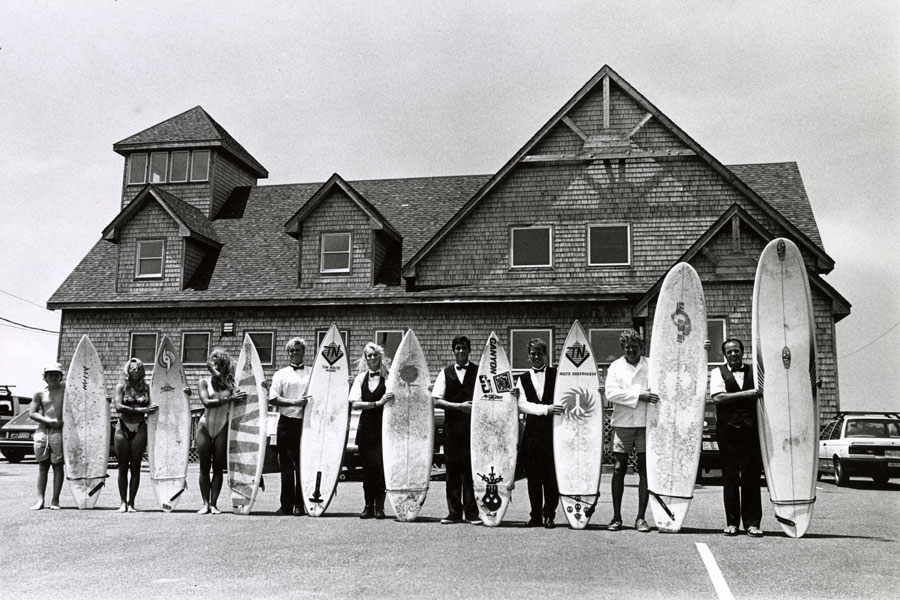
Image appears courtesy of the Outer Banks History Center, State Archives of North Carolina.
Ronnie Gray, who grew up in Nags Head and is part of the family who owns Gray’s Department Store, remembers catching his first wave at age 8 in 1964 at Nags Head Pier on his older brother Larry’s 9’6” Jacobs with ¾” redwood stringers. “The board was as heavy as me,” he says. Larry had ordered it from California, and he and his buddies had already been surfing for a few years by then. His brother gave him a push into his first wave, and Ronnie was hooked for life.
Many locals remember Sherald K. "Governor" Ward renting boards, which he had picked up in Florida, at Anderson's Market south of Kitty Hawk Pier. He also formed the Outer Banks Surf Club in 1964. The Governor made custom license plates for club members, and owning one offered exclusive beach parking.
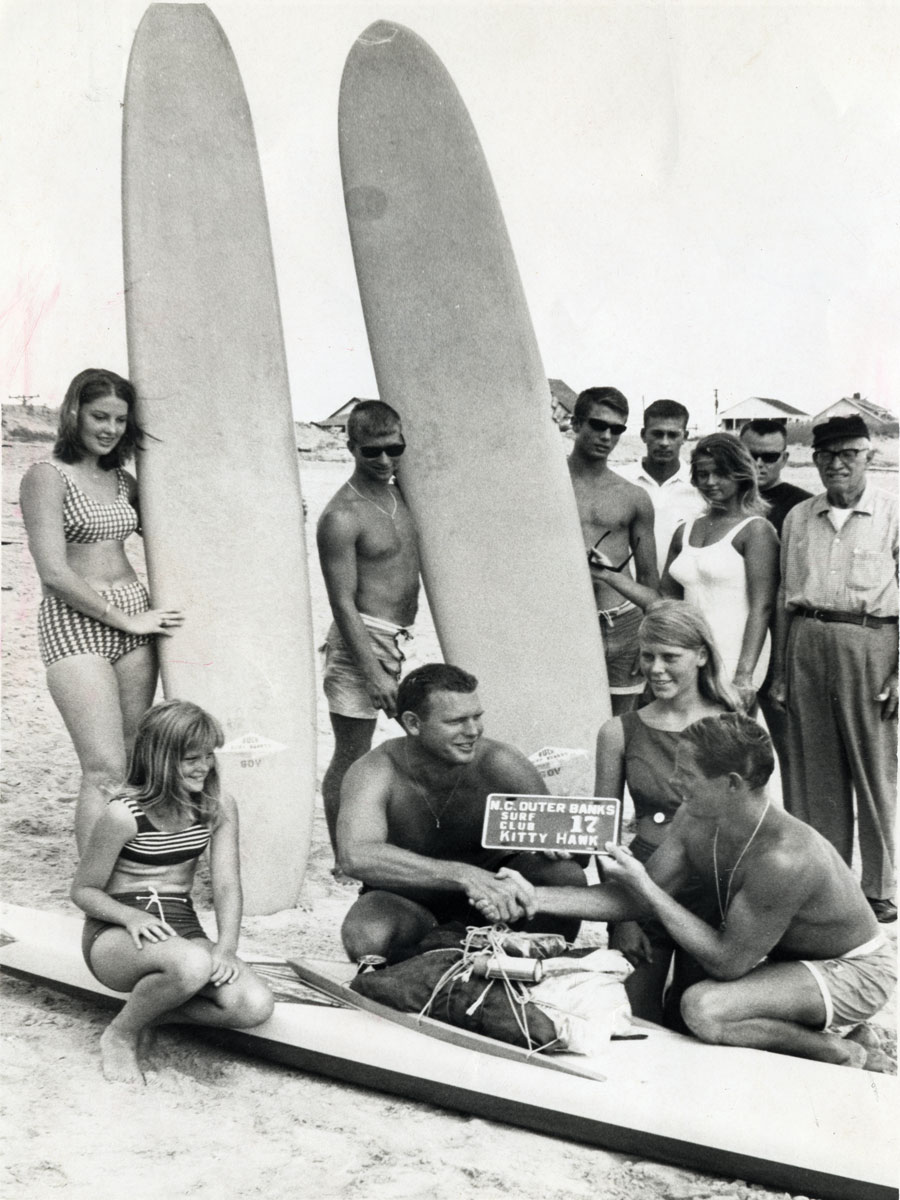
Throughout the '60s and '70s, the scene grew rapidly. Surf contests were held all along the East Coast, and both men and women surfers were competing. The first Nags Head Surfing Tournament in 1966 had riders braving waves from Hurricane Faith. That same year, the Nags Head Surfing Association was formed, and the group did community service projects to help improve the reputation of surfers (probably the result of clashes between pier owners and surfers).
Surfers from other towns along the East Coast started to take notice and make trips to the Outer Banks. In 1966 Sports Illustrated ran an article called “Riding the Wave of the East Coast’s Surfing Boom,” in which Bob Holland showed world-renowned California surfer Phil Edwards the breaks of the Outer Banks. That same year surf photographer Ron Stoner and an entourage of 20 Californian surfers traveled the length of the Banks, which resulted in the article “South to Kitty Hawk” in Surfer Magazine in July of 1967.
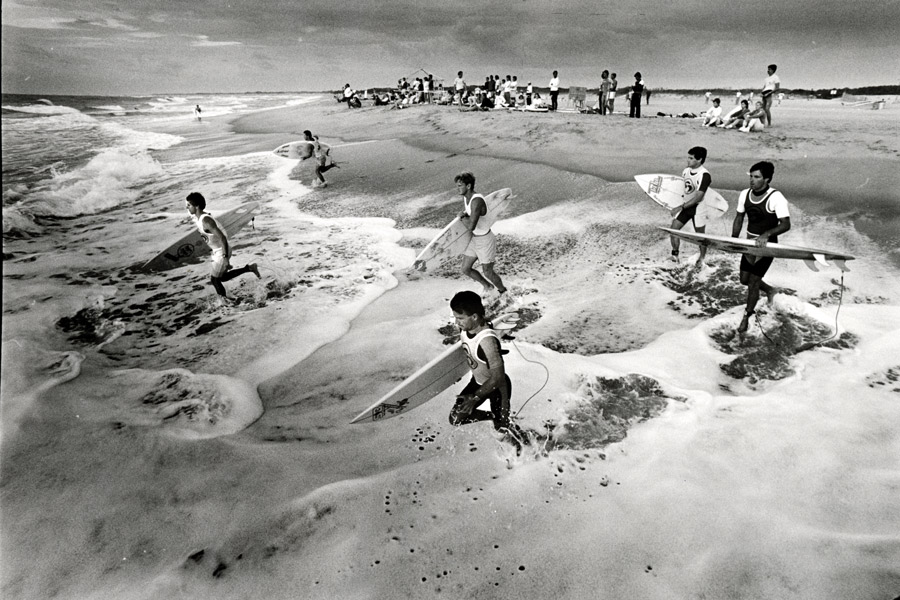
Image appears courtesy of the Outer Banks History Center, State Archives of North Carolina.
Contests were ramping up on the Outer Banks as well. In September 1971 the Eastern Surfing Association’s Championship was held at Cape Hatteras. The contest was started in 1968 and was supposed to be an East Coast circuit series, but it was held in Dare County every year after 1971. A big deal for Outer Banks surfing was when the U.S. Surfing Championship was held in Buxton in 1974, the first time the competition had been held on the East Coast since it was started in 1959. The competition returned to Buxton in 1978 and 1982.
By the 1980s the Outer Banks was known worldwide and was making the covers of many surfing magazines. Top surfers from across the country made the pilgrimage to Cape Hatteras. Even Kelly Slater, widely regarded as the greatest surfer of all time, trained and competed here, inspiring the local surfers.
The local guys were winning competitions too. Bob Holland racked up seven United States Surfing Championship titles and 12 East Coast titles and was the first East Coast surfer to win at the U.S. Open Championships of Surfing on the West Coast. Lynn Shell, who lived on Hatteras Island at the time and now owns Outer Banks Boarding Company in Nags Head, was the first North Carolinian to win the men’s longboard competition in the 1980 East Coast Surfing Championships and the Men’s Senior Division in 1991 and 1993.
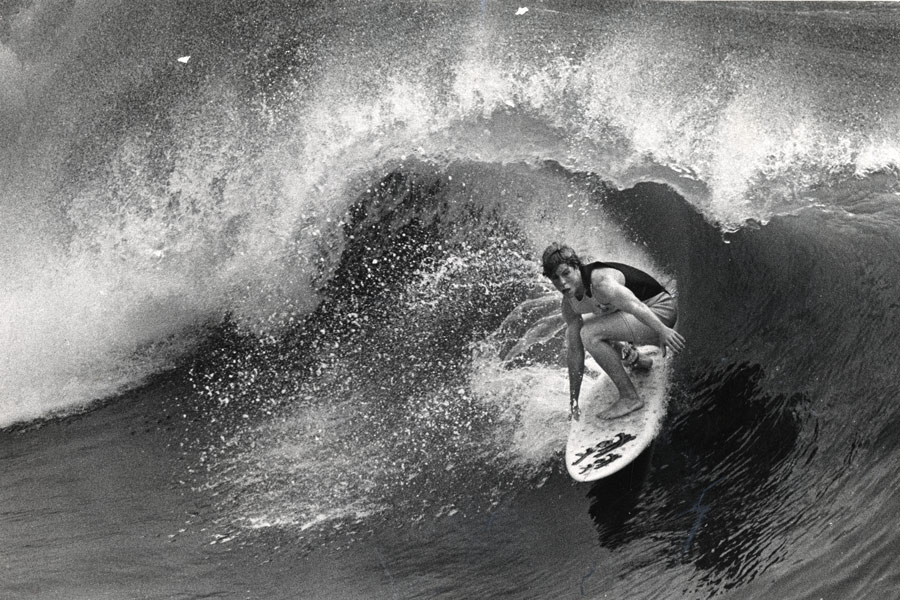
Image appears courtesy of the Outer Banks History Center, State Archives of North Carolina.
In 1980 the Outer Banks got its own district in the Eastern Surfing Association (ESA), breaking away from its dual district with Virginia Beach. Led by female surfer Dorothy Dunn, the new district included surfers from Dare, Currituck and Hyde counties. In 1982, Dunn won the Women’s Division of the U.S. Surfing Championships in Buxton. The strong local ESA chapter has been credited with the huge rise of surfing popularity on the Outer Banks and gave rise to many young competitors. By participating in local contests, competitors can accumulate enough points to qualify them to compete in regional events. Top winners in the regionals can then compete in September in the National ESA Eastern Championship, better known as the Easterns. The Easterns were traditionally held in Buxton, but now they are held every year at Jennette’s Pier in Nags Head.
In 1991 a chapter of Surfrider Foundation was created on the Outer Banks, with many local surfers beginning to advocate for environmental protections and clean water and opposing offshore oil drilling. In Surfing NC, Hairr and Wunderly write, “For many, the culture goes beyond the act of riding waves; it’s about lifestyle, values, and the environment. Surfers generally have a deep-rooted respect for Mother Nature, advocating for the preservation of beaches and marine environments. This ethos illustrates how surfing intertwines with broader societal issues, making it a powerful vehicle for awareness and change.”
In the 1990s, homegrown professional surfers like Noah Snyder (considered the Outer Banks’ first professional surfer), Billy Hume, Jesse Hines and Matt Beacham started winning competitions, getting magazine covers and featured in films, and gaining national attention, which only fueled more interest in Outer Banks surfing. They inspired today’s competitors, including professional surfer Brett Barley from Buxton.
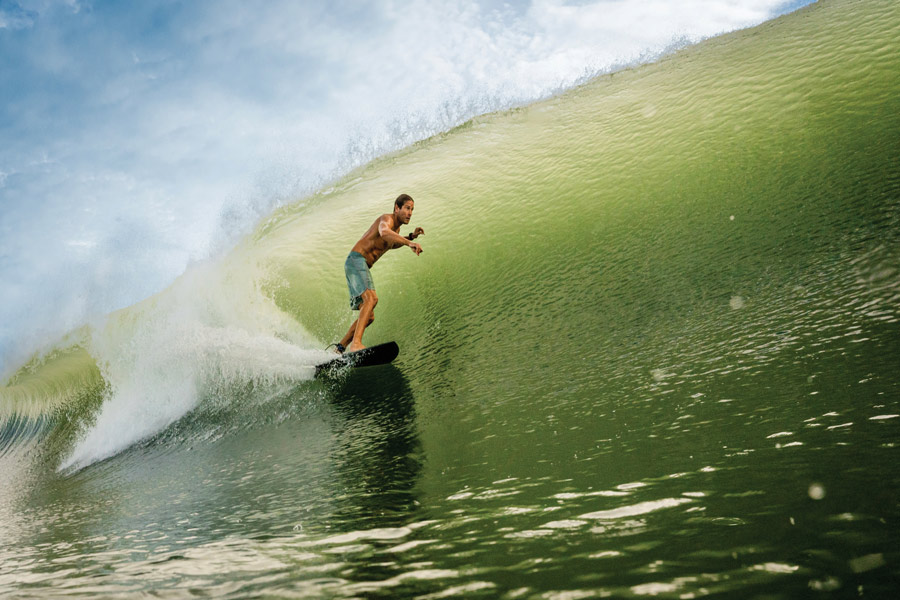
The 1990s also saw an increase in women participating in surfing, with local women like Leanne Robinson coming onto the scene. Robinson was sponsored by Secret Spot Surf Shop growing up, and now she’s co-owner of the shop and mentoring and sponsoring young riders, like 17-year-old Will Deane and 13-year-old Annie Peters, who have both been racking up wins. Another impressive female Outer Banks surfer is Patti Hook, a longtime surfer who has not let her MS diagnosis stop her from surfing. She transitioned to kneeboarding and placed second in the 2024 Kneeboarding World Championships in Jeffrey’s Bay, South Africa.
Today, surfing is entrenched in the Outer Banks culture, and the sport is still growing. The old surfer stereotype of laidback ne’er-do-well certainly no longer holds – surfers now are young, old, professional and blue collar. Christian surfers and women’s groups bond through surfing. More girls and women and young people are entering the sport than ever, and there is more participation from all levels of surfers. Kids learn to surf in grade school summer camps, and tourists get lessons. Whole families surf together.
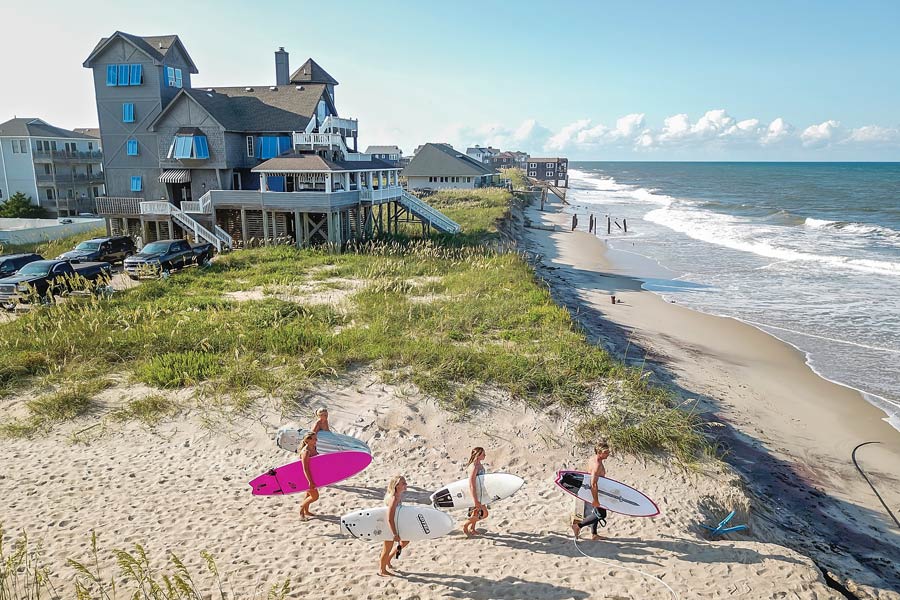
Surfing the Outer Banks has definitely changed over the decades. The boards are lighter than the early behemoths, and the wetsuits and gear are more technical. Surf cams and the internet broadcast the best breaks (to the chagrin of many), but there are still secret spots for those willing to seek them out.
Some surfers just want to ride their longboard in warm summer waves. Others don’t think twice about squeezing into a wetsuit, hood and booties for a winter session in 50-degree water. Some surfers love competing in local competitions, and some are good enough to take their skills to the national and global stage. Some want to travel to exotic locales, while others just want to surf the break closest to their house.
But the spirit of surfing is the same. Surfing here is about connection to the ocean, to the community and to a legacy that stretches back decades.
Outer Banks Shapers and Shops: A Brief History
The Outer Banks surf scene spawns numerous surfing-related businesses. For all these decades, surfers have been drawn not only to the waves of the Outer Banks, but also to the small communities. Making boards, running surf shops, renting boards and operating surf schools are ways to make a living here and stay immersed in the surfing lifestyle.
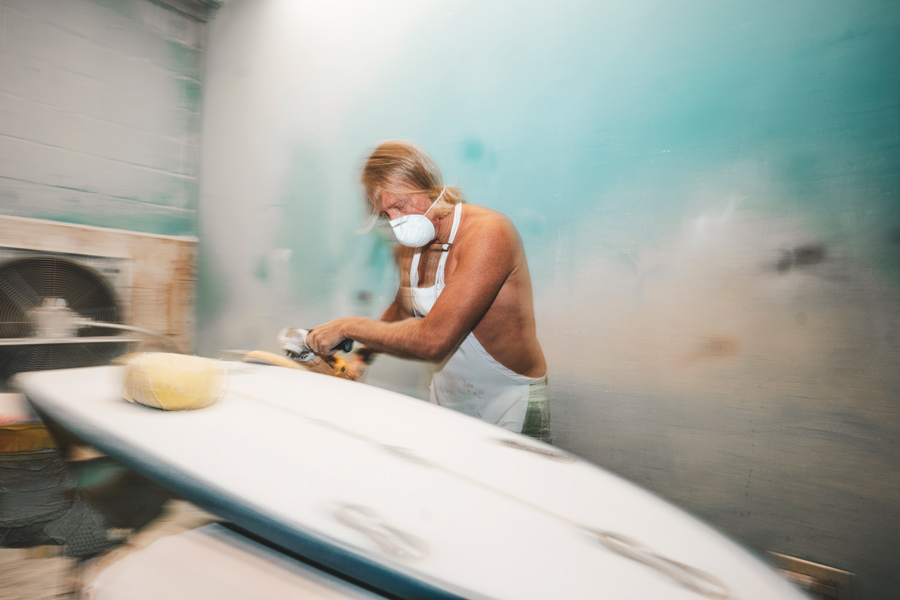
Image appears courtesy of the Outer Banks History Center, State Archives of North Carolina.
A robust surfboard-shaping industry grew up alongside the sport. At first it was just individuals experimenting with building boards. Surfing NC credits Don Bennett with being one of the first true surfboard builders on the Outer Banks. In the early 1960s he built and sold them in Kitty Hawk, then relocated a few times until Surfboards by Don ended up on the beach road in Nags Head. Down in Hatteras, longtime Outer Banks surfer and surfboard shaper David Rohde remembers surfer Bill Millicent building boards in the late 1960s.
The 1970s saw the launch of full-fledged surfboard-shaping businesses on the Outer Banks, with several guys moving into the area from Florida or Virginia Beach.
In 1970 Bill Frierson, a California surfer, opened a surfboard-shaping business in Kitty Hawk. Four years later Frierson and Les Shaw bought Wave Riding Vehicles (WRV) surfboards in Virginia Beach and over the years grew WRV into one of the biggest national names in surfboards and surf retail. In 1987, they moved their surfboard shaping arm, U.S. Fiberglass Products from Virginia Beach to the Outer Banks (Point Harbor). Their boards are sold across the world, and they have WRV showrooms in Kitty Hawk, Virginia Beach, Puerto Rico and Hawaii. Just some of the well-known shapers associated with WRV boards are Robert Manville, Jim Fuller, Patrick Herle, David Rohde and Jesse Fernandez.
In 1971 Barton Decker opened Hatteras Island Surf Shop in the old post office in Waves and was the first dealer for WRV boards. The shop is still there today.
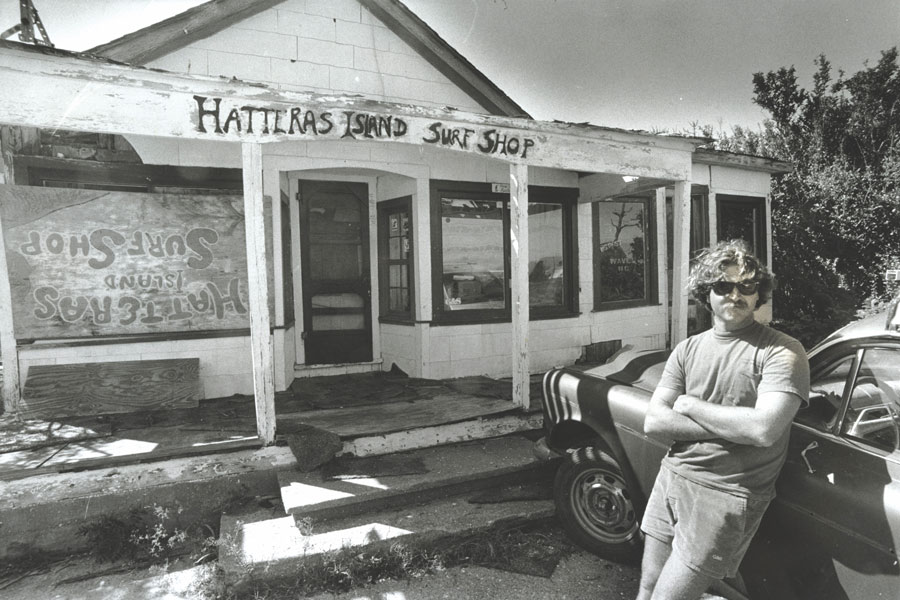
Image appears courtesy of the Outer Banks History Center, State Archives of North Carolina.
In May of 1974, Ted James, who had been shaping boards in Florida since 1968, began manufacturing Fox Surfboards in Buxton. He later became interested in windsurfing and built boards for that sport in Buxton. His Fox Watersports, credited with helping to establish windsurfing and kiteboarding in the area, is still in Buxton.
In 1975 Florida transplant Jim “Biggie” Vaughn arrived in town to open a second location of a Florida store called Resin Craft. The first location was at Whalebone Junction and that was the shop’s name too, as of 1977. It was the last stop for the scoop on the waves before driving to Hatteras, so plenty of surfers stopped. The shop, renamed Whalebone Surf Shop, moved and opened new locations around the Outer Banks and in Virginia Beach and Raleigh. The Nags Head location at MP 10 is celebrating 50 years with a new owner continuing the tradition.
1975 was also the year that Cocoa Beach surfers and shapers Scott Busbey, Pete Dooley, Greg Loehr, Rich Price and Tom Maus moved their Natural Art board-making business from Florida to Buxton. But after the first winter, Busbey says, most of the wives wanted out of Buxton, and the whole business moved back to Florida. However, Busbey and his wife, Carol, loved Cape Hatteras and moved back to Buxton in 1977. They opened Natural Art Surf Shop, and Busbey, who had been making boards since 1968, started a new line of boards, In the Eye Surfboards, which he still crafts today. One of his protégés was Lynn Shell, who went on to become a master shaper himself.
Up the beach, New Sun Surfboards came along in 1980 when surfers Mickey McCarthy and Mike Hamil opened up a shop and shaping room on the beach road in Nags Head. Originally from Virginia Beach, Mickey had previously shaped for WRV. Hamil left the business, and Mickey went on to mentor a whole wave of board shapers – well-known names like Murray Ross, Mike Beveridge, Scott Perry, Steve Head, Ted Kearns, Mike Rowe and Rascoe Hunt of Gale Force Glass. Mickey was equally known as a surf photographer who documented surfing and contests.
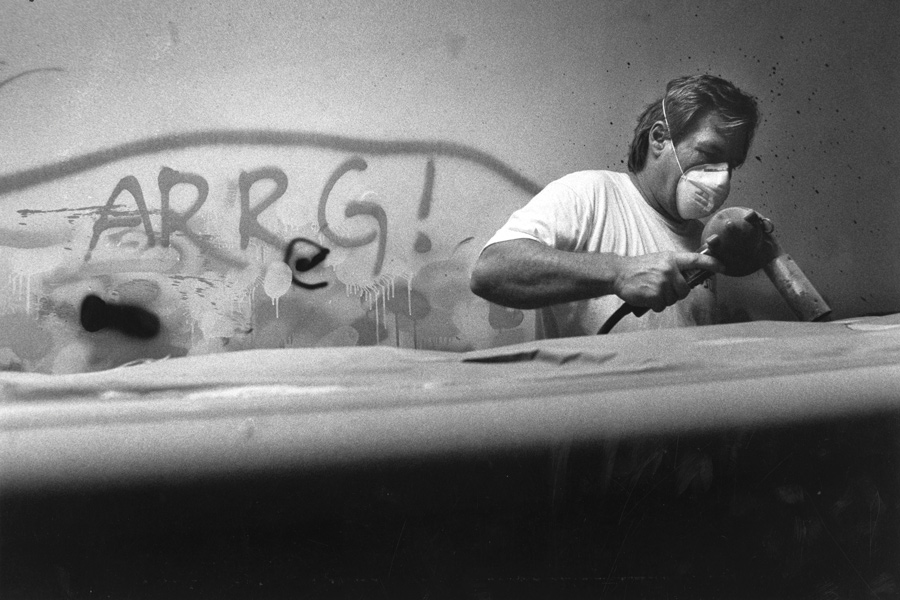
Image appears courtesy of the Outer Banks History Center, State Archives of North Carolina.
In 1982 Steve Hess opened Secret Spot Surf Shop in Nags Head. A surfer since 60s and shaper since 70s, Hess made Secret Spot boards with Mike Price and sold the boards at the shop. The shop was known for sponsoring young competitive riders. One of them, Leanne Robinson, ended up buying the shop with co-owners Nikki and Shawn Deane, and they still sponsor up-and-coming riders.
Cavalier Surf Shop on the beach road in Nags Head dates back to 1985. The 1960s building on the beach road was a laundry/surf shop when the Slayton family bought it. They transitioned it to a surf shop only, and the family-run business, with parents Marty and Ken and their son, Jerry, at the helm, is in its 40th season.
Ocracoke’s first surf shop, Ride the Wind, opened in 1985. Bob and Jane Chestnut bought Ride the Wind in 1999. Jane grew up coming to Ocracoke, and Bob had been surfing since the 1990s. Their surf school and retail shop is the epicenter of Ocracoke surfing.
In 1989 Debbie Bell and Randy Hall opened Rodanthe Surf Shop, making surfboards under the name Hatteras Glass. New owners as of 2012 are Jason and Lovie Heilig. Jason had experience in surfboard building at some big shops in California and now keeps up the Hatteras Glass building in Rodanthe. Their surf shop is the only place to buy Hatteras Glass boards.
In 1996, Gary Smith opened the first surf shop on the northernmost Outer Banks, Corolla Surf Shop. It’s still there today under different ownership.
1998 Virginia Beach surfer Bob Hovey, who had surfed professionally and competed around the globe, started Duck Village Outfitters. There are still DVO stores in Duck and Salvo.
Trip Forman and Matt Nuzzo opened REAL Watersports in Waves in 2001. The two have been named among the Top 10 Most Influential People in the History of Kiteboarding, and their primary focus is on kiteboarding but also includes surfing rentals, lessons and gear.
Lynn Shell, a championship-winning surfer, opened Outer Banks Boarding Company in Nags Head in 2002, in the former Bert’s Surf Shop location. Shell is surf-industry veteran who has been shaping boards for more than 40 years, starting in 1978 at In the Eye Surfboards alongside Scott Busbey. His own boards, Shell Shapes, have been shaped for labels such as WRV, HIC, Superbrand, Town and Country and Outer Banks Boarding Company.
Hatteras Island Board Sports in Avon opened in 2002, carrying boards made by Mark Newton. It’s still there today.
The Outer Banks’ newest surf shop, Outer Surf, is a family-run shop in Nags Head. It started with Outer Banks native Bri Young’s dream to start an all-girls’ surf club called Outer Babes in 2016. That surf club evolved into Outer Surf in 2018, a surf shop that offers surf camps and lessons, retreats and community events.
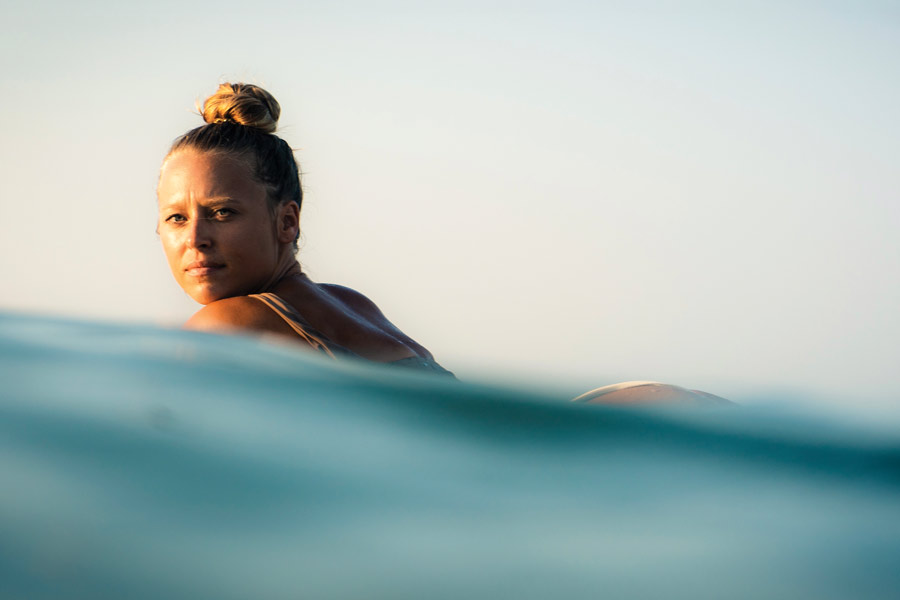
Lost to time are places like Harris Surf & Ski in Kitty Hawk, Vitamin Sea in Kill Devil Hills and The Pit, a legendary surf shop that Ben Sproul and Steve Pauls started on the beach road in Nags Head in 1994 and moved to the bypass in Kill Devil Hills in 1996. It thrived as a surf shop, restaurant and nightclub before closing in 2014.
Thanks to Surfing NC: A Timeline of the History of the Sport of Surfing in North Carolina for a great deal of this information. Deep apologies to all the characters and history that were not mentioned in this story due to the sheer volume of legends and stories on the Outer Banks and the lack of space to mention them all.
Surf Scene Events
From grassroots gatherings to world-class competitions, the Outer Banks surf calendar is packed with events that celebrate the sport. Here are a few of the local events.
Surfing for Autism
Jennette’s Pier | July
Surfing for Autism is an Autism Spectrum Disorder awareness event held each Summer on the Outer Banks of NC that provides our participants with an opportunity to surf. Each participant is partnered with two surfers and a skilled therapist or teacher who are well educated in the special needs of people with autism. Together, they experience paddling, surfing and other creative ways to have fun in the sun.
WRV Outer Banks Pro
Jennette’s Pier, Nags Head | Late August – Early September
A premier stop on the World Surf League’s Qualifying Series, this competition draws elite surfers from around the globe. Hosted at Jennette’s Pier, the WRV Pro is one of the East Coast’s most respected contests.
ESA Easterns Surfing Championships
Jennette’s Pier, Nags Head | September
The Eastern Surfing Association (ESA), the largest amateur surfing organization in the world, hosts its championship finale on the Outer Banks each fall.
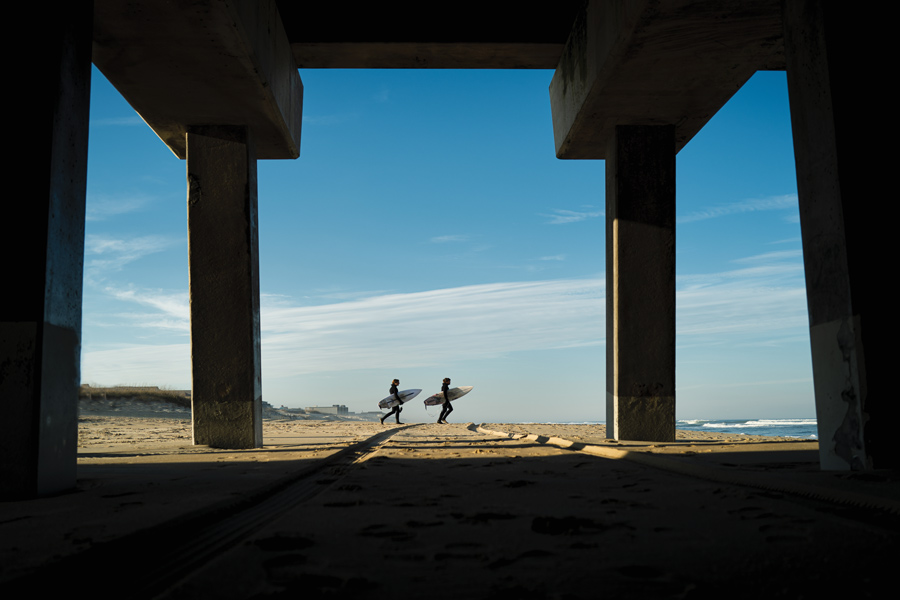
Surfalorus Film Festival
N.C. Aquarium on Roanoke Island, Jennette’s Pier | September
A cinematic love letter to the ocean, Surfalorus showcases surf films and documentaries. It’s three days of films during the Easter Surf Championships.
Throwdown Surf Classic
Southern Shores | September
A local, family-friendly surf contest features contest levels for all ages and raises money for a local cause.
Down the Road Surf & Art Festival
Kitty Hawk | October
A true locals’ celebration, this festival blends surf, art and music into one unforgettable weekend, plus it supports local causes.
WhichCraft Surf Gathering
Kill Devil Hills | October
Surf competitions, music and art to benefit Outer Banks Relief Foundation. Homebase is Swells’a Brewing.

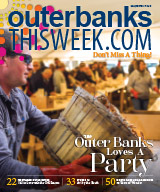
 Molly Harrison is managing editor at OneBoat, publisher of OuterBanksThisWeek.com. She moved to Nags Head in 1994 and since then has made her living writing articles and creating publications about the people, places and culture of the Outer Banks.
Molly Harrison is managing editor at OneBoat, publisher of OuterBanksThisWeek.com. She moved to Nags Head in 1994 and since then has made her living writing articles and creating publications about the people, places and culture of the Outer Banks.


